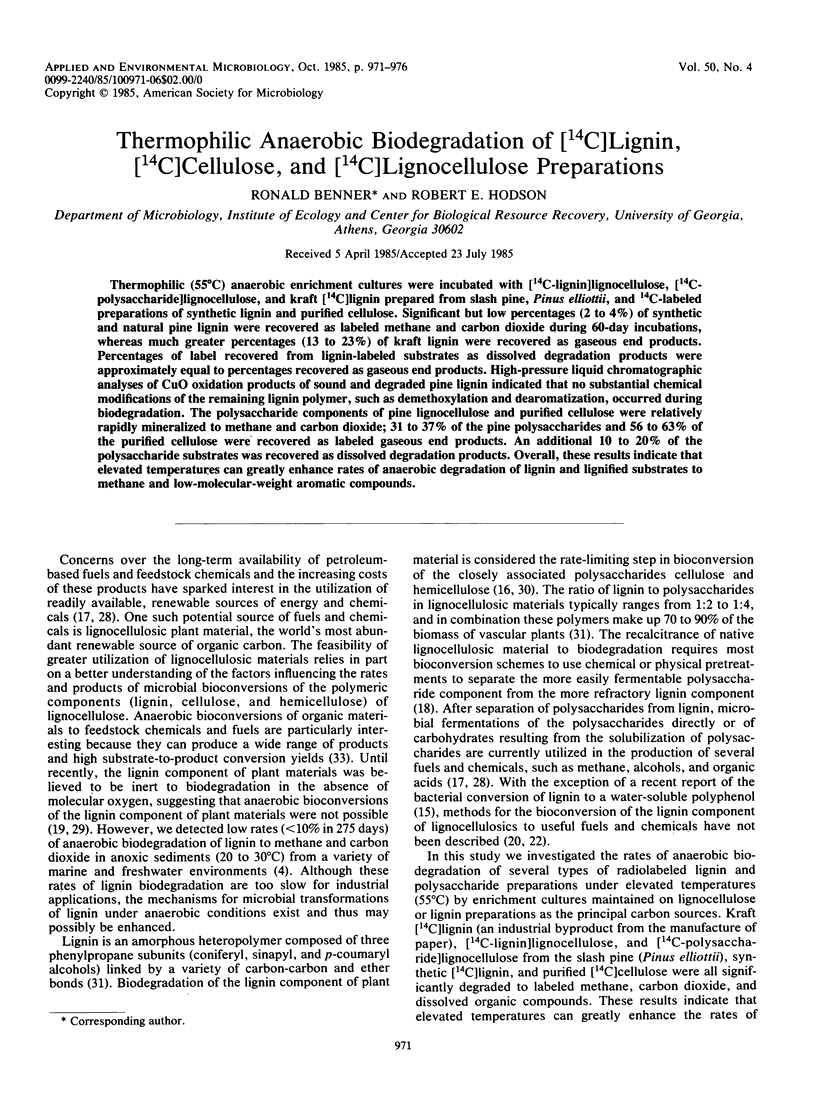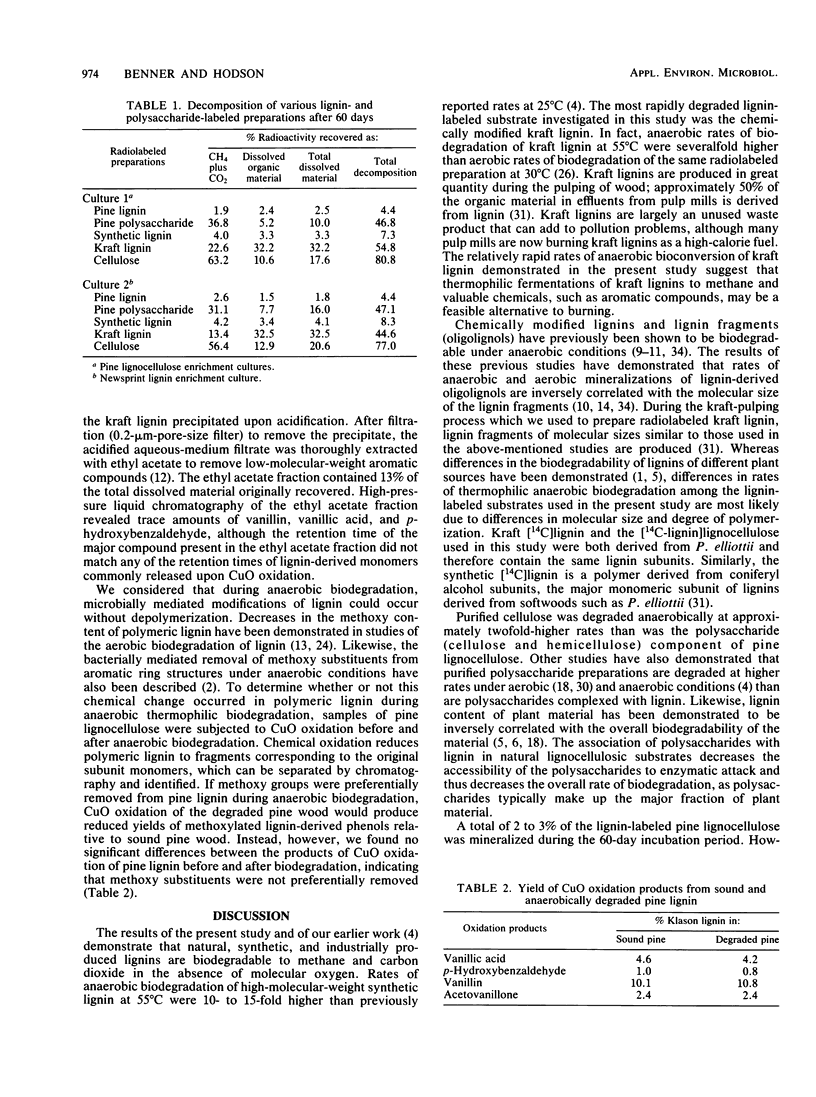Abstract
Thermophilic (55°C) anaerobic enrichment cultures were incubated with [14C-lignin]lignocellulose, [14C-polysaccharide]lignocellulose, and kraft [14C]lignin prepared from slash pine, Pinus elliottii, and 14C-labeled preparations of synthetic lignin and purified cellulose. Significant but low percentages (2 to 4%) of synthetic and natural pine lignin were recovered as labeled methane and carbon dioxide during 60-day incubations, whereas much greater percentages (13 to 23%) of kraft lignin were recovered as gaseous end products. Percentages of label recovered from lignin-labeled substrates as dissolved degradation products were approximately equal to percentages recovered as gaseous end products. High-pressure liquid chromatographic analyses of CuO oxidation products of sound and degraded pine lignin indicated that no substantial chemical modifications of the remaining lignin polymer, such as demethoxylation and dearomatization, occurred during biodegradation. The polysaccharide components of pine lignocellulose and purified cellulose were relatively rapidly mineralized to methane and carbon dioxide; 31 to 37% of the pine polysaccharides and 56 to 63% of the purified cellulose were recovered as labeled gaseous end products. An additional 10 to 20% of the polysaccharide substrates was recovered as dissolved degradation products. Overall, these results indicate that elevated temperatures can greatly enhance rates of anaerobic degradation of lignin and lignified substrates to methane and low-molecular-weight aromatic compounds.
Full text
PDF





Selected References
These references are in PubMed. This may not be the complete list of references from this article.
- Antai S. P., Crawford D. L. Degradation of softwood, hardwood, and grass lignocelluloses by two streptomyces strains. Appl Environ Microbiol. 1981 Aug;42(2):378–380. doi: 10.1128/aem.42.2.378-380.1981. [DOI] [PMC free article] [PubMed] [Google Scholar]
- Benner R., Maccubbin A. E., Hodson R. E. Anaerobic biodegradation of the lignin and polysaccharide components of lignocellulose and synthetic lignin by sediment microflora. Appl Environ Microbiol. 1984 May;47(5):998–1004. doi: 10.1128/aem.47.5.998-1004.1984. [DOI] [PMC free article] [PubMed] [Google Scholar]
- Benner R., Maccubbin A. E., Hodson R. E. Preparation, characterization, and microbial degradation of specifically radiolabeled [C]lignocelluloses from marine and freshwater macrophytes. Appl Environ Microbiol. 1984 Feb;47(2):381–389. doi: 10.1128/aem.47.2.381-389.1984. [DOI] [PMC free article] [PubMed] [Google Scholar]
- Colberg P. J., Young L. Y. Anaerobic degradation of soluble fractions of [C-lignin]lignocellulose. Appl Environ Microbiol. 1985 Feb;49(2):345–349. doi: 10.1128/aem.49.2.345-349.1985. [DOI] [PMC free article] [PubMed] [Google Scholar]
- Colberg P. J., Young L. Y. Aromatic and Volatile Acid Intermediates Observed during Anaerobic Metabolism of Lignin-Derived Oligomers. Appl Environ Microbiol. 1985 Feb;49(2):350–358. doi: 10.1128/aem.49.2.350-358.1985. [DOI] [PMC free article] [PubMed] [Google Scholar]
- Crawford D. L., Floyd S., Pometto A. L., 3rd, Crawford R. L. Degradation of natural and Kraft lignins by the microflora of soil and water. Can J Microbiol. 1977 Apr;23(4):434–440. doi: 10.1139/m77-064. [DOI] [PubMed] [Google Scholar]
- Crawford D. L., Pometto A. L., 3rd, Crawford R. L. Production of useful modified lignin polymers by bioconversion of lignocellulose with Streptomyces. Biotechnol Adv. 1984;2(2):217–232. doi: 10.1016/0734-9750(84)90006-5. [DOI] [PubMed] [Google Scholar]
- Hackett W. F., Connors W. J., Kirk T. K., Zeikus J. G. Microbial decomposition of synthetic C-labeled lignins in nature: lignin biodegradation in a variety of natural materials. Appl Environ Microbiol. 1977 Jan;33(1):43–51. doi: 10.1128/aem.33.1.43-51.1977. [DOI] [PMC free article] [PubMed] [Google Scholar]
- Kirk T. K., Connors W. J., Bleam R. D., Hackett W. F., Zeikus J. G. Preparation and microbial decomposition of synthetic [14C]ligins. Proc Natl Acad Sci U S A. 1975 Jul;72(7):2515–2519. doi: 10.1073/pnas.72.7.2515. [DOI] [PMC free article] [PubMed] [Google Scholar]
- Maccubbin A. E., Hodson R. E. Mineralization of detrital lignocelluloses by salt marsh sediment microflora. Appl Environ Microbiol. 1980 Oct;40(4):735–740. doi: 10.1128/aem.40.4.735-740.1980. [DOI] [PMC free article] [PubMed] [Google Scholar]
- Ng T. K., Busche R. M., McDonald C. C., Hardy R. W. Production of feedstock chemicals. Science. 1983 Feb 11;219(4585):733–740. doi: 10.1126/science.219.4585.733. [DOI] [PubMed] [Google Scholar]
- Odier E., Monties B. Absence of microbial mineralization of lignin in anaerobic enrichment cultures. Appl Environ Microbiol. 1983 Sep;46(3):661–665. doi: 10.1128/aem.46.3.661-665.1983. [DOI] [PMC free article] [PubMed] [Google Scholar]
- Zeikus J. G. Chemical and fuel production by anaerobic bacteria. Annu Rev Microbiol. 1980;34:423–464. doi: 10.1146/annurev.mi.34.100180.002231. [DOI] [PubMed] [Google Scholar]


